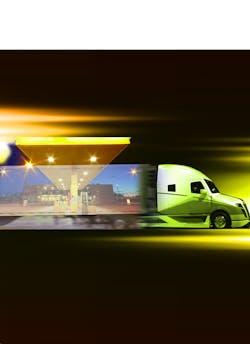Back in 2010, the Environmental Protection Agency kicked off the first steps of its long-term plan to reduce greenhouse gas (GHG) emissions from commercial vehicles. Phase 1 of the greenhouse gas and fuel efficiency standards were for model-year 2014-2018 vehicles. The California Air Resources Board estimated the first phase would save $8.5 billion in fuel costs and 5 billion gals. of diesel fuel nationally by 2020. Now, EPA and the National Highway Transportation Safety Administration (NHTSA) are taking that a step further with Phase 2 regulations, announced this summer, covering 2018-2027 vehicles.
In this next phase, EPA and NHTSA are proposing efficiency and GHG standards for trailers for the first time. The EPA trailer standards, which exclude certain categories such as mobile homes, would begin to take effect in model-year 2018, while NHTSA’s standards would be in effect as of 2021.
The future of fuel economy
Click the links for stories on:
Engines: Power and efficiency
Trucks: Match game
Operations: Finding an edge
Trailers: Expecting more
For Phase 1, Avron Mitchum, EPA program manager, estimated the cost to implement technologies needed to meet the rules ranges between $5,000 and $6,000, with annual fuel savings from $1,500 to $3,750 based on application. How Phase 2, which is more stringent, plays out is anyone’s guess, but EPA estimates it will add between $10,000 and $12,000 to the cost of a tractor-trailer with payback coming in two years for a tractor-trailer combination, three years for pickups and vans, and six years for vocational vehicles.
The Phase 2 standards are expected to lower CO2 emissions by about 1 billion metric tons, cut fuel costs by about $170 billion, and reduce oil consumption by up to 1.8 billion barrels over the lifetime of the vehicles sold under the program, EPA said.
The American Trucking Assns. announced that it supports the proposal, but remains concerned that the rule may result in the use of certain technologies on vehicles before they can be fully tested.
“Fuel is an enormous expense for our industry—and carbon emissions carry an enormous cost for our planet,” Bill Graves, president and CEO, said. “That’s why our industry supported the Obama administration’s historic first round of greenhouse gas and fuel efficiency standards for medium and large trucks and why we support the aims of this second round of standards.”
When fully implemented, heavy-duty vehicles across all classes would achieve up to the following CO2 emissions and fuel use reductions:
◗ 24% for combination tractors designed to pull trailers and move freight when compared to Phase 1 standards
◗ 8% for trailers when compared to an average model-year 2017 trailer
◗ 16% for vocational vehicles when compared to Phase 1 standards
◗ 16% for pickup trucks and light vans when compared to Phase 1 standards
Put simply, experts at the Environmental Defense Fund pegged the 2027 goal at about 9.5 mpg for highway tractor-trailers, compared to about 6 mpg in 2010.
There are separate standards for engines, similar to Phase 1. For diesel engines, the proposed standards would begin in model-year 2021 and phase in to MY 2027, with interim standards in MY 2024.
The proposed diesel engine standards would reduce CO2 emissions and fuel consumption by up to 4% compared to Phase 1.
